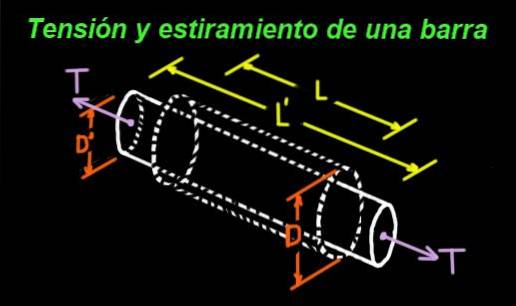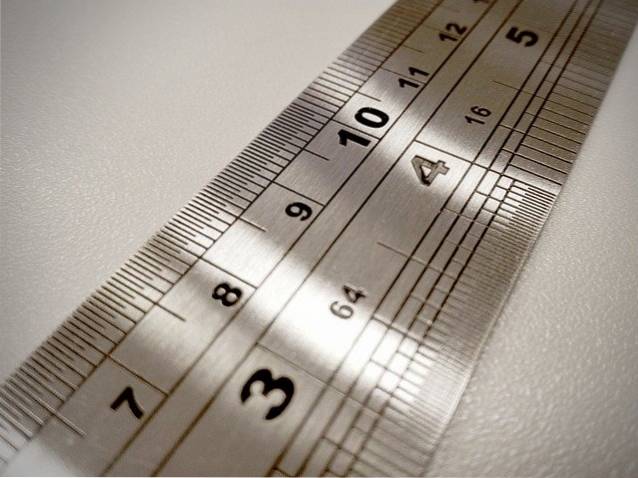
Poisson's ratio, formulas, values, examples
The Poisson's ratio it is a dimensionless quantity, characteristic of each material. It is an indication of the deformation of a piece of material before the application of certain forces.
When a piece of material that is subjected to a tension, or a compression, undergoes a deformation, the quotient between the transverse deformation and the longitudinal deformation is precisely the Poisson's ratio.

For example, a rubber cylinder that is subjected to tension at its ends stretches in the longitudinal direction, but narrows transversely. Figure 1 shows a bar whose original dimensions are: length L and diameter D.
The bar is subjected to a tension T at its ends, and as a consequence of this tension it undergoes a stretch, so that the new length is L '> L. But when it is stretched, its diameter also narrows to the new value: D ' < D.
The quotient between the stretch (positive) and the narrowing (negative) multiplied by (-1), is a positive number between 0 and 0.5. This number is the so-called Poisson's ratio ν (Greek letter nu).
Article index
- 1 Poisson's ratio formula
- 1.1 Relationship with the modulus of elasticity and the modulus of rigidity
- 2 Value of Poisson's ratio for materials
- 3 Calculation examples
- 3.1 Example 1
- 3.2 Example 2
- 4 References
Poisson's ratio formula
To calculate the Poisson's ratio it is necessary to determine the longitudinal and transverse strain.
The longitudinal strain εL is the stretch divided by the original length:
εL = (L '- L) / L
Similarly, the transverse strain εT is the radial taper divided by the original diameter:
εT = (D '- D) / D
Therefore, the Poisson's ratio is calculated using the following formula:
ν = - εT / εL
Relationship with modulus of elasticity and modulus of rigidity
The Poisson's ratio ν, is related to the modulus AND elasticity (or Young's modulus) and with the modulus of rigidity G, using the following formula:
ν = E / (2G) - 1
Poisson's ratio value for materials


Calculation examples
Example 1
A bar of a certain plastic material has a length of 150 mm and a circular section of 20 mm in diameter. When subjected to a compression force F of 612.25 kg-f, a shortening of 14 mm is observed and simultaneously an increase of 0.85 mm in the diameter of the bar.
Calculate:
a) Longitudinal strain.
b) The transverse strain.
c) The Poisson's ratio of that material.
d) Young's modulus of elasticity corresponding to the material.
e) The modulus of rigidity for that plastic.
Solution to
Recall that the longitudinal strain εL is the stretch divided by the original length:
εL = (L '- L) / L
εL = (-14 mm) / 150 mm = -0.0933
Note that the longitudinal strain is dimensionless, and in this case it has been negative because there was a decrease in its longitudinal dimension.
Solution b
Similarly, the transverse strain εT is the radial taper, divided by the original diameter:
εT = (D '- D) / D
εT = (+0.85 mm) / 20 mm = 0.0425
The transverse strain has been positive because there has been an increase in the diameter of the bar.
Solution c
For the calculation of Poisson's ratio we must remember that it is defined as the negative of the quotient between the transverse deformation and the longitudinal deformation:
ν = - εT / εL
ν = - 0.0425 / (-0.0933) = 0.4554
It should be remembered that the Poisson's ratio is a positive dimensionless number and for most materials it is between 0 and 0.5.
Solution d
Young's modulus of elasticity, denoted by the letter E, is the constant of proportionality in Hooke's law. By E, the normal stress σL is related to the strain εL, as follows:
σL = E εL
Normal stress is defined as the quotient between the normal force (in this case parallel to the axis of the bar) and the cross section of area:
σL = F / A = F / (π / 4 * D ^ 2)
In this exercise, the force F is 612.25 kg-f, which must be converted to newtons, which is the SI unit of force:
F = 612.25 kg-f = 612.25 * 9.8 N = 6000 N = 6 kN
For its part, the cross section of area A is:
A = (π / 4 * D ^ 2) = (3.1416 / 4) * (20 * 10 ^ -3 m) ^ 2 = 3.1416 * 10 ^ -4 m ^ 2
Finally the normal stress applied to the bar is:
σL = F / A = 6000 N / 3.1416 * 10 ^ -4 m ^ 2 = 19.098.593 Pa = 19.098 MPa
To calculate Young's modulus of elasticity we solve for E from Hooke's law σL = E εL:
E = σL / εL = 19,098,593 Pa / 0.0933 = 204.7 MPa
Solution e
The modulus of stiffness G is related to Young's modulus E and Poisson's ratio ν by this formula:
E / (2 G) = 1 + ν
From there you can solve for G:
G = E / (2 (1 + ν)) = 204.7 MPa / (2 (1 + 0.4554)) = 70.33 MPa
Example 2
There is a copper cable with a diameter of 4 mm and 1 m long. Knowing that the Young's modulus of copper is 110,000 MPa and that its Poisson's ratio is 0.34, estimate the stretching and narrowing in diameter that the wire undergoes when a weight of 100 kg-f is hung on it..
Solution
First, it is necessary to calculate the normal tensile stress that the weight exerts on the wire, following this formula:
σL = F / A = F / (π / 4 * D ^ 2)
The force F is 980 N and the cross sectional area is:
A = (π / 4 * D ^ 2) = (3.1416 / 4) * (4 * 10 ^ -3 m) ^ 2 = 1.2566 * 10 ^ -5 m ^ 2
Then the tensile stress is:
σL = 980 N / 1.2566 * 10 ^ -5 m ^ 2 = 77,986,000 Pa
Wire Strain Calculation
Young's modulus of elasticity, denoted by the letter E, is the constant of proportionality in Hooke's law that relates the normal stress σL to the strain εL:
σL = E εL
From there the longitudinal strain of the copper wire can be solved:
εL = σL / E = 77.986 MPa / 110000 MPa = 7.09 * 10 ^ -4
Calculation of transverse strain
On the other hand, to know the transverse strain, the Poisson's ratio is applied:
ν = - εT / εL
Finally, we have that the transverse strain is:
εT = -ν εL = - 0.34 * 7.09 * 10 ^ -4 = -2.41 * 10 ^ -4
Calculation of absolute cable stretch
Finally, to know the absolute stretch of the cable, the following relationship must be applied:
ΔL = εL * L = 7.09 * 10 ^ -4 * 1 m = 7.09 * 10 ^ -4 m = 0.709 mm
That is, with that weight the cable barely stretched 0.709 millimeters.
Calculation of the decrease in diameter
To obtain the absolute shrinkage in diameter we use the following formula:
ΔD = εT * D = -2.41 * 10 ^ -4 * 4 mm = -9.64 * 10 ^ -4 mm = -0.000964 millimeters.
This narrowing in diameter is so small that it is difficult to see with the naked eye, even its measurement requires a high precision instrument.
References
- Beer F… Mechanics of materials. 5th. Edition. 2010. Mc Graw Hill. 1-130.
- Hibbeler R. Mechanics of materials. Eighth edition. Prentice Hall. 2011. 3-60.
- Gere J. Mechanics of materials. Eighth edition. Cengage Learning. 4-220.
- Giancoli, D. 2006. Physics: Principles with Applications. 6th Ed. Prentice Hall. 238-242.
- Valera Negrete, J. 2005. Notes on General Physics. UNAM. 87-98.



Yet No Comments